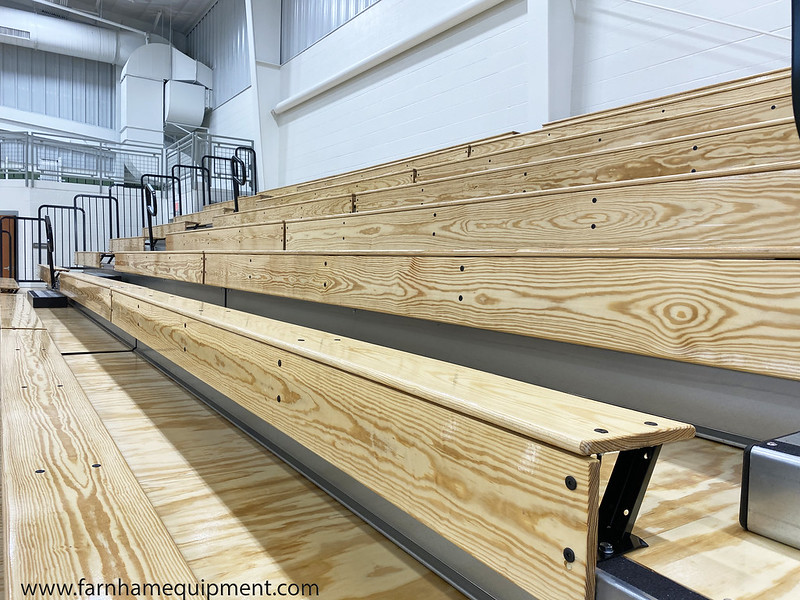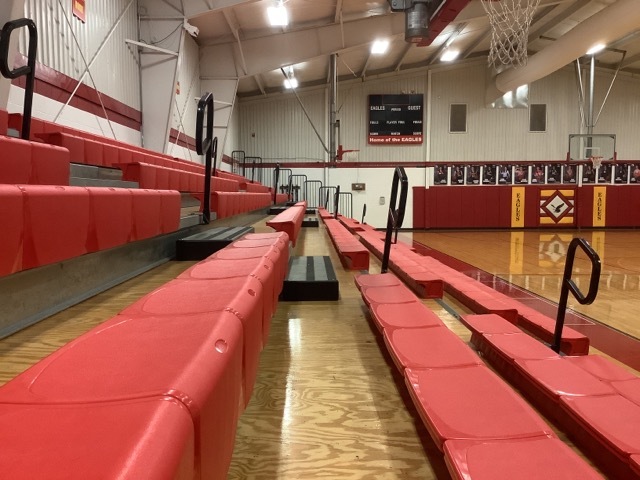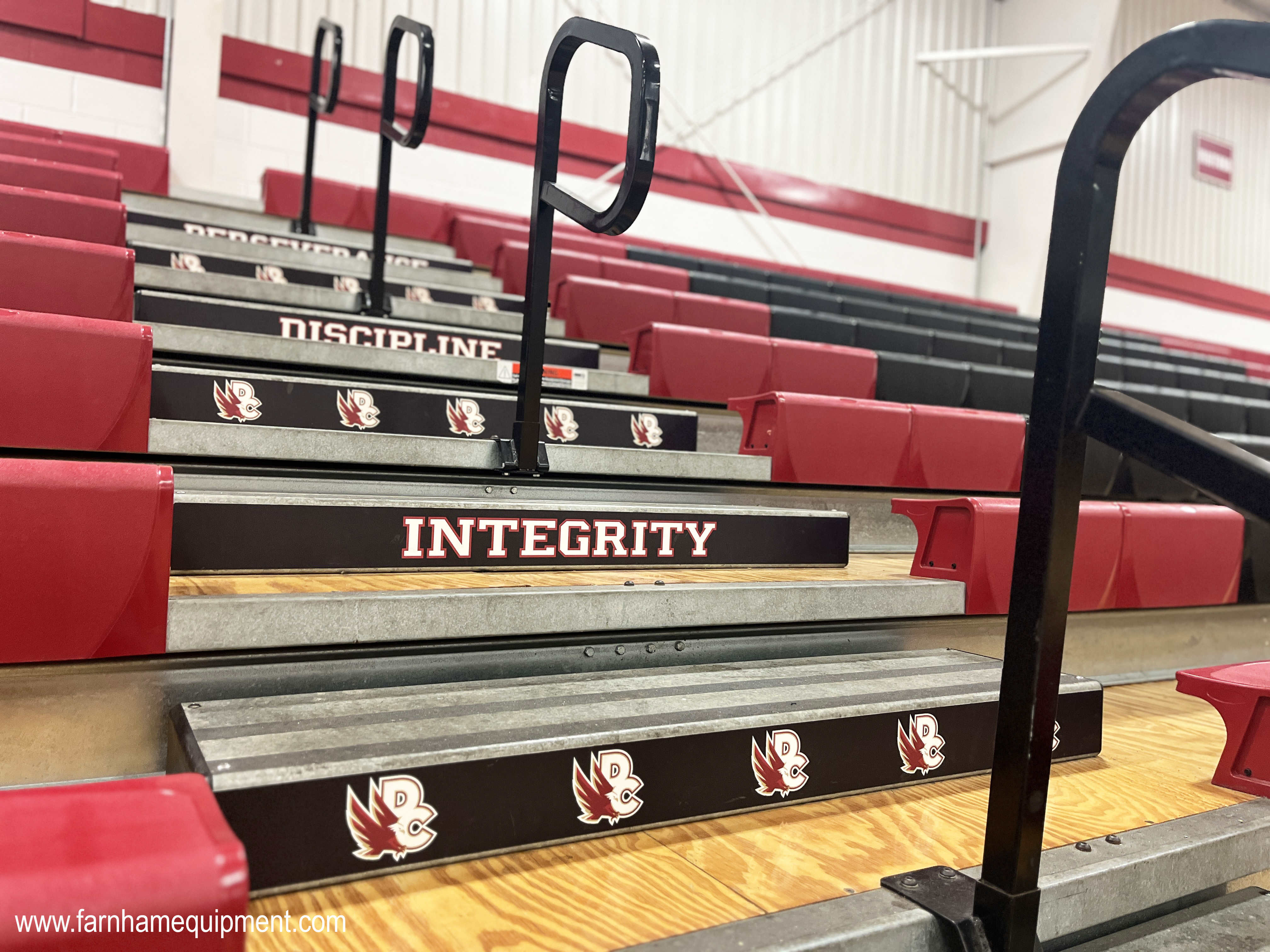In Part 2.2, we discussed the two of the more common code violation: gaps that do not prohibit the passage of a 4-inch sphere and failure to use the front to first row aisle steps. In this section we’re going to talk about some common items that should be pointed out during an inspection due to safety hazards that can also cause structural damage.
Remember in our first post, we mentioned: “The keywords here are safe and sanitary.” The bottom line is that you are responsible for everyone that is using your equipment on your property and your responsibility is to provide an environment that is free of recognized hazards. That said, here are a few common safety violations that also impact the structural components for telescopic bleachers.
Bearing Surface: This is the space underneath your telescopic bleachers both in the open and closed position. Often, cleaning up the mess after a big game means to close the bleachers and clean the floor where debris fell through. This is a good start, but you have to also beware of what lingers on the bearing surface where the bleachers sit in a closed position. This is where dust and debris tend to collect.
What Does it Impact? The most obvious reason to clean under the bleacher is for sanitary reasons, from food, soda, wrappers, and dust this is a breeding ground for bacteria. The sometimes not so obvious reason: It can do some major damage to your understructure. The dust and debris can cause a domino effect with damage to the drive wheels that will impair tracking and alignment and this type of damage isn’t covered under your warranty because it is 100% preventable.
When you are closing power bleachers, row one goes under row two and pushes both under row three and then pushes all three under row four and so on getting heavier as they go. Once you have all of the rows closed under the others, except the last row or two, is when the bleachers begin losing their traction and need your assistance to close all the way. This is where the dust is causing the drive wheels to lose that traction. Now if it happens much before that, your wheels have picked up too much dust and are spinning in it creating a glazed smooth drive wheel instead of a gripping tire.
Your bleachers automatically realign themselves by closing completely and opening completely. When the bleachers loose traction and do not close completely and they are then opened, they do not come out straight. Coming back out, the portion that did not close all of the way has a head start and is ahead of the other sections that did close. This can, and does, bend the structural components and can even break them to the point that they need to be replaced. A bleacher inspection that does not include the inspecting person opening and closing your bleachers is not a complete inspection.
But our bleachers are wall-to-wall, no gaps more than 4-inches, and we can only access this area through our access hatch… You would be amazed at what can fall through tiny openings. Even though unauthorized access to the understructure is prevented with wall-to-wall bleachers, dust still gathers and will build up on your drive wheels.
What to do: Make cleaning the bearing surface part of your routine schedule and clean under the bleachers in the open position, clean where the bleachers sit in the closed position, then close the bleachers. Don’t cheat and close the bleachers then flip up the skirtboard and sweep between everything, this will leave more dust and debris where you do not want it the most.
Bent Cantilever Frame Arms: Are your bleachers sagging? Are you having trouble opening and closing your system? Your cantilever frame arms being bent or damaged is one of the most likely causes. Your bleachers are installed to last the lifetime of your facility with proper maintenance and care. Part of that maintenance and care is making sure that your bleachers are used properly. We’re not saying that everyone has to sit quietly in the stands and limit the shifting of their weight though. Our bleachers are installed for the most fanatic fan – in the open position. In every O&M manual, you’ll see a statement similar to this one:
“Do not allow people to climb, sit, or stand on tiers other than the Flex-Row modules of the MAXAM system while closed.” And, “Do not leave any section or bank open without the Flex-Row modules being open at the aisle locations.”
– Hussey MAXAM Owners & Maintenance Manual.
Students and patrons climbing and/or sitting on the top tier of the bleachers while they are in the closed position is one of the main ways cantilever frame arms get damaged. Another common problem we have seen is when people are sitting on the upper tiers in the closed position, they tend to want to jump down to the lower levels. This not only can be very dangerous for the person doing the jumping, but very bad for your cantilever arms and your bleacher decks. It will also be costly to repair since misuse of the system is not covered under the manufacturer’s warranty.
What does it impact? Cantilever frame arms are vital to the life of your bleachers. They attach to the main frame essentially holding up each bleacher deck which makes it easier to open and close your system. If they start to bend or drag, the bleacher decks will start to rest on top of one another causing unnecessary friction during operation and sometime stopping operation all together and causing a continuous flow of premature wear to spread through your seating system.
What to do? If you don’t already have warning labels or signs in place stating the bleachers should not be occupied in the fully or partially closed position, you should add them. If you are in need of these warning labels, you can contact us and we would be happy to get you what you need!
It’s best to be sure anyone using your system: Athletic Directors, Coaches, Maintenance, etc., is aware of these rules and guidelines because what may look like a cool place for students to sit could end up costing much more.
If you need only a small section of seating, you can use your Flex-Rows if you have them, otherwise you should open the entire bank. You also have the option for a secondary locking system for partial seating.
For example, with a 15-row bleacher, you can set a secondary locking system on the bleachers to open only 8 rows of seating and still be locked safely in the open position. When in this position, you can incorporate a top closure to cover the seating rows that are still in the closed position to prevent people from climbing, sitting, standing and storing things on telescopic bleachers while in the closed position. See how Botkins Local School District does this with their telescopic bleachers.
A couple more items to mention:
Hardware: Loose and missing hardware. This one is pretty basic, you want to make sure the hardware throughout your unit isn’t damaged, rusted, missing, or loose. This goes for the understructure, aisle rails, guardrails, seat components and so on. Your hardware should be looked at on a regular basis during normal operating procedures. If you see something wrong you should fix it or have it fixed to prevent additional damage to the components that it is holding together.
Missing or Damaged Row Locks: Row locks are an important component of all telescopic bleachers. They are needed to prevent one row from closing before it is intended to be closed to stay in the proper sequence. There are many people out there that work on bleachers that say it is ok to just take the row locks off if they get damaged if the bleacher is powered. This is not the case. The typical damage is from unauthorized people going under the bleachers, tripping on the row locks and bending them, causing additional problems. This also happens to some manufacturers’ interlocking guide rods. When you catch them with your foot and they pull out, the structural frames are no longer interlocked together and it creates a problem with guidance and structural support.
Damaged Seats: Cracked, damaged, and loose seating can cause an unstable seating surface for your patrons and can cause a cut hazard with sharp edges and splinters. Baseballs can break the faces of Wood Planks/Riser Boards and the faces of Plastic Seat Modules. People stomping on the tops of seats can break holes in them also. When either one is broken, there are sharp edges that can injure your spectators. These items should be repaired. Loose hardware on seats can also cause someone to fall resulting in personal injury and liability.











0 Comments